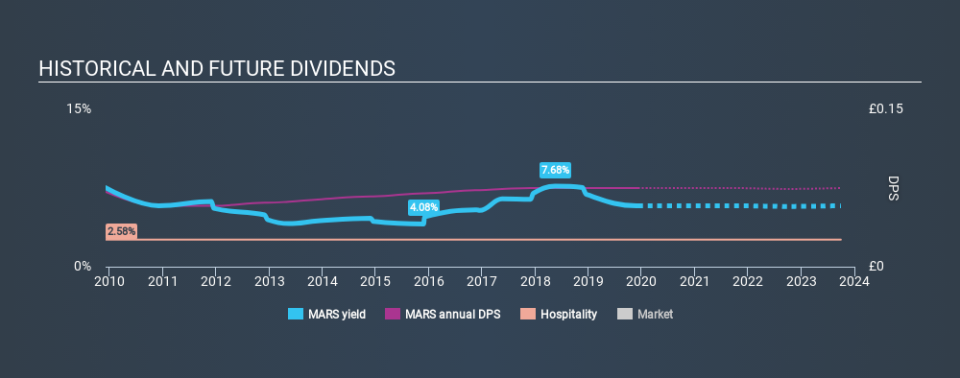Income Investors Should Know That Marston's PLC (LON:MARS) Goes Ex-Dividend Soon

Marston's PLC (LON:MARS) is about to trade ex-dividend in the next 3 days. Ex-dividend means that investors that purchase the stock on or after the 12th of December will not receive this dividend, which will be paid on the 27th of January.
Marston's's next dividend payment will be UK£0.048 per share. Last year, in total, the company distributed UK£0.075 to shareholders. Looking at the last 12 months of distributions, Marston's has a trailing yield of approximately 5.8% on its current stock price of £1.29. We love seeing companies pay a dividend, but it's also important to be sure that laying the golden eggs isn't going to kill our golden goose! As a result, readers should always check whether Marston's has been able to grow its dividends, or if the dividend might be cut.
Check out our latest analysis for Marston's
Dividends are typically paid out of company income, so if a company pays out more than it earned, its dividend is usually at a higher risk of being cut. Marston's lost money last year, so the fact that it's paying a dividend is certainly disconcerting. There might be a good reason for this, but we'd want to look into it further before getting comfortable. Given that the company reported a loss last year, we now need to see if it generated enough free cash flow to fund the dividend. If Marston's didn't generate enough cash to pay the dividend, then it must have either paid from cash in the bank or by borrowing money, neither of which is sustainable in the long term. Over the last year, it paid out more than three-quarters (77%) of its free cash flow generated, which is fairly high and may be starting to limit reinvestment in the business.
Click here to see the company's payout ratio, plus analyst estimates of its future dividends.
Have Earnings And Dividends Been Growing?
Companies with consistently growing earnings per share generally make the best dividend stocks, as they usually find it easier to grow dividends per share. If earnings fall far enough, the company could be forced to cut its dividend. Marston's reported a loss last year, but at least the general trend suggests its income has been improving over the past five years. Even so, an unprofitable company whose business does not quickly recover is usually not a good candidate for dividend investors.
Many investors will assess a company's dividend performance by evaluating how much the dividend payments have changed over time. Marston's's dividend payments are effectively flat on where they were ten years ago.
Get our latest analysis on Marston's's balance sheet health here.
The Bottom Line
Has Marston's got what it takes to maintain its dividend payments? It's hard to get used to Marston's paying a dividend despite reporting a loss over the past year. At least the dividend was covered by free cash flow, however. All things considered, we are not particularly enthused about Marston's from a dividend perspective.
Wondering what the future holds for Marston's? See what the 13 analysts we track are forecasting, with this visualisation of its historical and future estimated earnings and cash flow
If you're in the market for dividend stocks, we recommend checking our list of top dividend stocks with a greater than 2% yield and an upcoming dividend.
If you spot an error that warrants correction, please contact the editor at editorial-team@simplywallst.com. This article by Simply Wall St is general in nature. It does not constitute a recommendation to buy or sell any stock, and does not take account of your objectives, or your financial situation. Simply Wall St has no position in the stocks mentioned.
We aim to bring you long-term focused research analysis driven by fundamental data. Note that our analysis may not factor in the latest price-sensitive company announcements or qualitative material. Thank you for reading.

 Yahoo Finance
Yahoo Finance 
